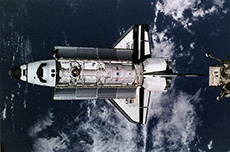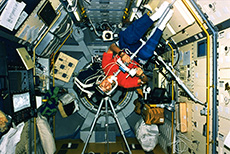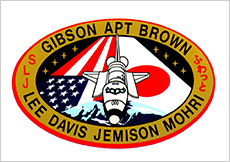Q. Did anyone in Japan have any experience with space experiments before the FMPT?

The Space Shuttle with Spacelab loaded on board (courtesy: NASA)
Around the time the FMPT got started in 1980, the National Space Development Agency of Japan (NASDA, now part of JAXA) already had experience with experiments in space using rockets. It wasn’t like they didn’t have any knowhow – the equipment for experimenting with materials was fairly well developed. Experiments using small rockets last only about six minutes in zero gravity, but I think we were able to learn some fundamental things. On the other hand, the FMPT involved sending an astronaut into space to conduct the experiments, so the rockets were much bigger. So it seems to me that NASDA pretty much started from scratch with its manned space experiments.
Meanwhile the Spacelab program, developed in Europe, started conducting experiments in 1983, and we learned what sort of tests they were conducting on the Space Shuttle. Japanese researchers also participated in experiments in Spacelab.
Q. How were the FMPT experiments chosen and planned out?

Astronaut Mamoru Mouri practicing a materials experiment inside a training version of Spacelab
In 1979, we put out a public call for ideas, and received 103 suggestions, out of which 34 were selected. Twenty-two of these were materials experiments – using microgravity in the production of new materials – while 12 were life-science experiments – for example, investigating how fish are affected by space sickness. I think the great number of ideas we received was due to the excitement there was around space-related science at the time.
Because most of the experiments we did in space concerned materials, there was a lot of talk at the time about building a space factory later on. I guess this is why they put the word “Material” in First Material Processing Test, the name of the mission. However, after experiments began on the shuttle and we realized how expensive it was to go to space and back, we decided that we ought to focus more on life-science experiments using the space environment, rather than trying to build a manufacturing facility in space.
Q. What were some of the difficulties in executing the FMPT?

Astronaut Mamoru Mouri conducting an experiment (courtesy: JAXA/NASA)
At the time, my assignment was to assemble all the laboratory equipment for life-science experiments. Overall, it was a tough job, that’s the only way I can describe it. One problem was that there were many people involved.
Many rockets and satellites are made by a single manufacturer, but in the case of the FMPT there were a lot of interests involved besides the company making the lab equipment. Even though I am not a researcher and don’t have as much scientific expertise, I had to coordinate between NASA and various other parties, including the scientists conducting the experiments and the equipment manufacturers, so arranging everything was hard work.
Then, because it was Japan’s first set of experiments in space, we wanted as many researchers to participate as possible, so we probably planned too many experiments. It was very difficult to control everything and move things forward. Our racks were so jam-packed that NASA asked us to assemble the racks by ourselves because NASA could not do that.
Since the FMPT consisted of manned experiments, the safety of the astronauts came first. NASA’s safety standards are extremely strict, so meeting them was the toughest part. NASA guidelines on design safety were written in general terms, so even at NASA there was a lot of debate over how to interpret them. And after the Challenger accident in 1986, they started to take an even tougher line on designing safe experiments. Some things that had previously passed inspection now failed, which made my job even harder.


